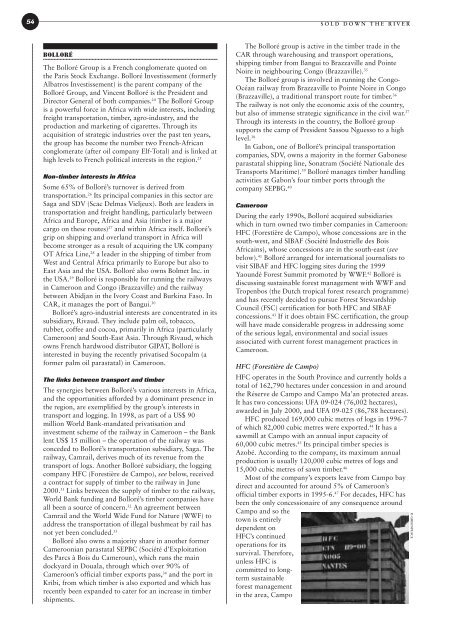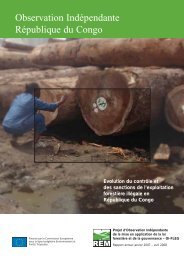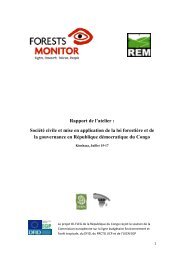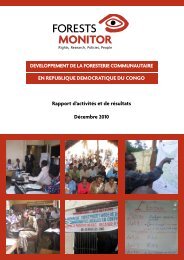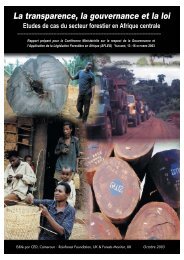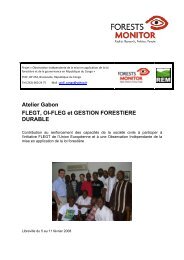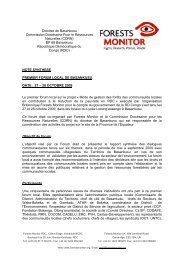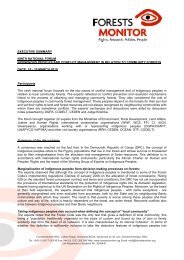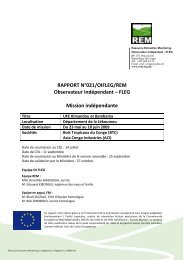Sold down the river - Salva le Foreste
Sold down the river - Salva le Foreste
Sold down the river - Salva le Foreste
You also want an ePaper? Increase the reach of your titles
YUMPU automatically turns print PDFs into web optimized ePapers that Google loves.
54SOLD DOWN THE RIVERBOLLORÉThe Bolloré Group is a French conglomerate quoted on<strong>the</strong> Paris Stock Exchange. Bolloré Investissement (formerlyAlbatros Investissement) is <strong>the</strong> parent company of <strong>the</strong>Bolloré Group, and Vincent Bolloré is <strong>the</strong> President andDirector General of both companies. 24 The Bolloré Groupis a powerful force in Africa with wide interests, includingfreight transportation, timber, agro-industry, and <strong>the</strong>production and marketing of cigarettes. Through itsacquisition of strategic industries over <strong>the</strong> past ten years,<strong>the</strong> group has become <strong>the</strong> number two French-Africanconglomerate (after oil company Elf-Total) and is linked athigh <strong>le</strong>vels to French political interests in <strong>the</strong> region. 25Non-timber interests in AfricaSome 65% of Bolloré’s turnover is derived fromtransportation. 26 Its principal companies in this sector areSaga and SDV (Scac Delmas Vieljeux). Both are <strong>le</strong>aders intransportation and freight handling, particularly betweenAfrica and Europe, Africa and Asia (timber is a majorcargo on <strong>the</strong>se routes) 27 and within Africa itself. Bolloré’sgrip on shipping and overland transport in Africa willbecome stronger as a result of acquiring <strong>the</strong> UK companyOT Africa Line, 28 a <strong>le</strong>ader in <strong>the</strong> shipping of timber fromWest and Central Africa primarily to Europe but also toEast Asia and <strong>the</strong> USA. Bolloré also owns Bolmet Inc. in<strong>the</strong> USA. 29 Bolloré is responsib<strong>le</strong> for running <strong>the</strong> railwaysin Cameroon and Congo (Brazzavil<strong>le</strong>) and <strong>the</strong> railwaybetween Abidjan in <strong>the</strong> Ivory Coast and Burkina Faso. InCAR, it manages <strong>the</strong> port of Bangui. 30Bolloré’s agro-industrial interests are concentrated in itssubsidiary, Rivaud. They include palm oil, tobacco,rubber, coffee and cocoa, primarily in Africa (particularlyCameroon) and South-East Asia. Through Rivaud, whichowns French hardwood distributor GIPAT, Bolloré isinterested in buying <strong>the</strong> recently privatised Socopalm (aformer palm oil parastatal) in Cameroon.The links between transport and timberThe synergies between Bolloré’s various interests in Africa,and <strong>the</strong> opportunities afforded by a dominant presence in<strong>the</strong> region, are exemplified by <strong>the</strong> group’s interests intransport and logging. In 1998, as part of a US$ 90million World Bank-mandated privatisation andinvestment scheme of <strong>the</strong> railway in Cameroon – <strong>the</strong> Bank<strong>le</strong>nt US$ 15 million – <strong>the</strong> operation of <strong>the</strong> railway wasconceded to Bolloré’s transportation subsidiary, Saga. Therailway, Camrail, derives much of its revenue from <strong>the</strong>transport of logs. Ano<strong>the</strong>r Bolloré subsidiary, <strong>the</strong> loggingcompany HFC (Forestière de Campo), see below, receiveda contract for supply of timber to <strong>the</strong> railway in June2000. 31 Links between <strong>the</strong> supply of timber to <strong>the</strong> railway,World Bank funding and Bolloré’s timber companies haveall been a source of concern. 32 An agreement betweenCamrail and <strong>the</strong> World Wide Fund for Nature (WWF) toaddress <strong>the</strong> transportation of il<strong>le</strong>gal bushmeat by rail hasnot yet been concluded. 33Bolloré also owns a majority share in ano<strong>the</strong>r formerCameroonian parastatal SEPBC (Société d’Exploitationdes Parcs à Bois du Cameroun), which runs <strong>the</strong> maindockyard in Douala, through which over 90% ofCameroon’s official timber exports pass, 34 and <strong>the</strong> port inKribi, from which timber is also exported and which hasrecently been expanded to cater for an increase in timbershipments.The Bolloré group is active in <strong>the</strong> timber trade in <strong>the</strong>CAR through warehousing and transport operations,shipping timber from Bangui to Brazzavil<strong>le</strong> and PointeNoire in neighbouring Congo (Brazzavil<strong>le</strong>). 35The Bolloré group is involved in running <strong>the</strong> Congo-Océan railway from Brazzavil<strong>le</strong> to Pointe Noire in Congo(Brazzavil<strong>le</strong>), a traditional transport route for timber. 36The railway is not only <strong>the</strong> economic axis of <strong>the</strong> country,but also of immense strategic significance in <strong>the</strong> civil war. 37Through its interests in <strong>the</strong> country, <strong>the</strong> Bolloré groupsupports <strong>the</strong> camp of President Sassou Nguesso to a high<strong>le</strong>vel. 38In Gabon, one of Bolloré’s principal transportationcompanies, SDV, owns a majority in <strong>the</strong> former Gaboneseparastatal shipping line, Sonatram (Société Nationa<strong>le</strong> desTransports Maritime). 39 Bolloré manages timber handlingactivities at Gabon’s four timber ports through <strong>the</strong>company SEPBG. 40CameroonDuring <strong>the</strong> early 1990s, Bolloré acquired subsidiarieswhich in turn owned two timber companies in Cameroon:HFC (Forestière de Campo), whose concessions are in <strong>the</strong>south-west, and SIBAF (Société Industriel<strong>le</strong> des BoisAfricains), whose concessions are in <strong>the</strong> south-east (seebelow). 41 Bolloré arranged for international journalists tovisit SIBAF and HFC logging sites during <strong>the</strong> 1999Yaoundé Forest Summit promoted by WWF. 42 Bolloré isdiscussing sustainab<strong>le</strong> forest management with WWF andTropenbos (<strong>the</strong> Dutch tropical forest research programme)and has recently decided to pursue Forest StewardshipCouncil (FSC) certification for both HFC and SIBAFconcessions. 43 If it does obtain FSC certification, <strong>the</strong> groupwill have made considerab<strong>le</strong> progress in addressing someof <strong>the</strong> serious <strong>le</strong>gal, environmental and social issuesassociated with current forest management practices inCameroon.HFC (Forestière de Campo)HFC operates in <strong>the</strong> South Province and currently holds atotal of 162,790 hectares under concession in and around<strong>the</strong> Réserve de Campo and Campo Ma’an protected areas.It has two concessions: UFA 09-024 (76,002 hectares),awarded in July 2000, and UFA 09-025 (86,788 hectares).HFC produced 169,000 cubic metres of logs in 1996-7of which 82,000 cubic metres were exported. 44 It has asawmill at Campo with an annual input capacity of60,000 cubic metres. 45 Its principal timber species isAzobé. According to <strong>the</strong> company, its maximum annualproduction is usually 120,000 cubic metres of logs and15,000 cubic metres of sawn timber. 46Most of <strong>the</strong> company’s exports <strong>le</strong>ave from Campo baydirect and accounted for around 5% of Cameroon’sofficial timber exports in 1995-6. 47 For decades, HFC hasbeen <strong>the</strong> only concessionaire of any consequence aroundCampo and so <strong>the</strong>town is entirelydependent onHFC’s continuedoperations for itssurvival. Therefore,un<strong>le</strong>ss HFC iscommitted to longtermsustainab<strong>le</strong>forest managementin <strong>the</strong> area, Campo© GREENPEACE


